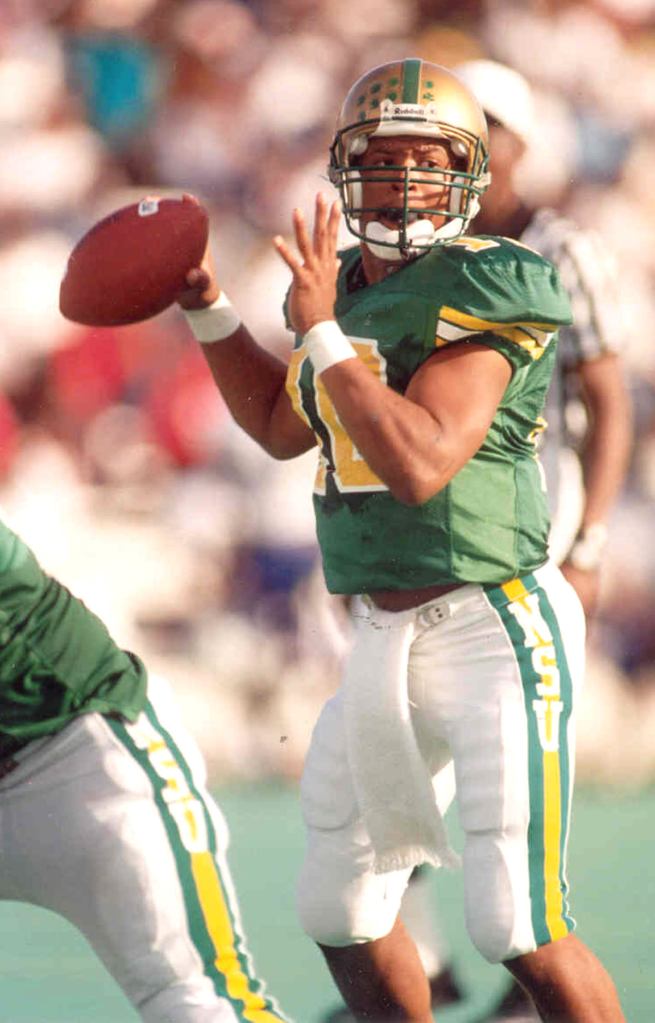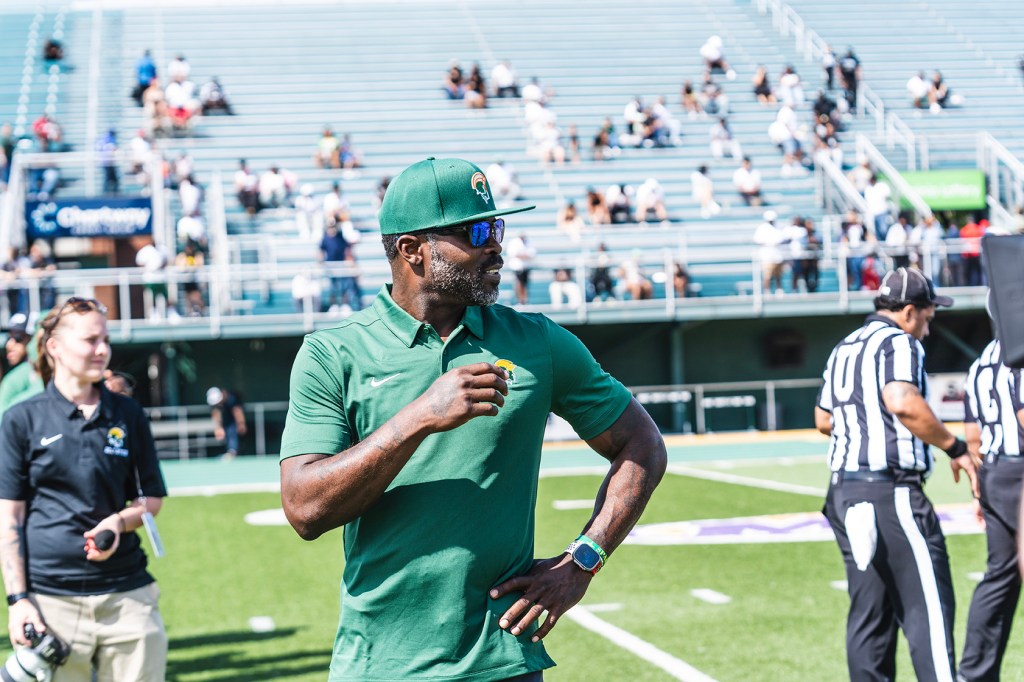Black Athletes in the Spotlight: HBCU Sports & Local Highlights
Norfolk State University has stepped into the spotlight of not just HBCU football, but college football as a whole by hiring Michael Vick.
The football program has long been a fixture in the HBCU sports world, but unlike its more decorated peers, its history has been defined more by mediocrity than momentum. As the Spartans prepare to open a new chapter under head coach Michael Vick in 2025, they do so carrying the weight of nearly nine decades of inconsistency. For all of its institutional pride and deep cultural roots as an HBCU, Norfolk State has yet to fully establish itself as a consistent football force—on the field, in recruiting, or in the national HBCU conversation.
An HBCU struggling to find an identity
Since first fielding a team in 1938, Norfolk State has compiled an overall record of 349–398–13, a mark that reflects how difficult sustained success has been. While other HBCU programs like Grambling State, Florida A&M, Jackson State, and South Carolina State have won national titles, produced NFL stars, and built legacy-driven brands, Norfolk State’s football story has lacked that kind of high-level breakthrough. The program has often hovered around .500 seasons, with occasional peaks overshadowed by longer stretches of underperformance.
Established the Norfolk Division of Virginia Union in 1935, the football team was first known as the “Baby Panthers.” The school underwent multiple name changes in its first decade, turning into a branch of Virginia State University in 1944 and then becoming the “Baby Trojans.” It finally got its own mascot in 1952 — becoming the Spartans — but football was still an afterthought.
During this period through the early 1960s, Norfolk State was a member of the EIAC. It played a mix of small Black colleges, junior colleges, “B” teams, and freshman squads. More than a dozen of its all-time wins came against non-varsity opponents like Swift Junior College, Virginia Seminary, and freshman teams from nearby HBCUs. While that was common among developing HBCUs of the time, it meant NSU didn’t gain early national HBCU football credibility. Unlike some rivals, Norfolk State didn’t face top-tier programs consistently in its formative decades.
The Spartans found some success in the mid-1970s under coach Dick Price, winning three consecutive CIAA championships (1974–1976), but the momentum didn’t last. It added a fourth CIAA title under Willard Bailey in 1984, but failed to win a title in its last dozen years in the league. NSU later moved up to Division I FCS (then I-AA) in 1997, joining the MEAC. But the jump didn’t yield a transformation. Instead, it highlighted the program’s struggle to compete at a higher level within the HBCU hierarchy.

New division, same problems
Perhaps the program’s brightest moment came in 2011, when head coach Pete Adrian led the Spartans to a MEAC title and an FCS playoff appearance. But even that accomplishment was short-lived—NCAA violations later forced the school to vacate all of its wins from that season, erasing a rare high point from the record books. In many ways, that episode has become a metaphor for NSU football itself: flashes of success, clouded by setbacks and missed opportunities.

As a Division I HBCU, Norfolk State has faced consistent challenges. The MEAC, where it has spent the bulk of its Division I era, was once among the strongest HBCU football conferences. Programs like South Carolina State, Bethune-Cookman, and North Carolina A&T dominated the standings for years, leaving NSU to fight for relevance. Between 1997 and 2024, Norfolk State finished with a winning conference record just a handful of times. Even with access to scholarships, upgraded facilities, and regional talent, the Spartans often ended up in the middle or bottom of the MEAC standings.
Part of the problem has been institutional instability. Norfolk State has cycled through more than a dozen head coaches since its inception. Few stayed long enough to build continuity. Administrative turnover and limited football investment—especially compared to FBS programs or top-performing HBCUs—hampered long-term planning. Meanwhile, Norfolk State’s location in the talent-rich Hampton Roads region became less of an advantage as FBS programs began dominating the recruiting landscape.
Nowhere was this more evident than in the rise of Old Dominion University, located just across town. ODU restarted its football program in 2009 and quickly rose to FCS prominence, joining FBS and Conference USA by 2014. With superior facilities, TV exposure, and the backing of state funding, ODU pulled attention, fans, and talent away from Norfolk State. The Spartans, once the face of college football in Norfolk, became overshadowed in their own backyard.
The program also lacked a defining football identity. While some HBCUs are known for their high-flying offenses, punishing defenses, or pipeline to the NFL, Norfolk State hasn’t consistently developed a signature style or legacy. It has sent some players to the pros—most notably DB Don Carey and WR James Roe—but has rarely been seen as a player factory like other HBCU powers.

Enter Michael Vick
The challenge facing Michael Vick in 2025 is enormous, despite his star power and local roots. The former NFL quarterback and Virginia Tech legend brings instant visibility and credibility to the program. His name alone has already sparked interest and anticipation that NSU hasn’t seen in decades. But Vick is inheriting a program that has gone a combined 19–37 since 2019, with no winning seasons and declining attendance.
Turning Norfolk State into a consistent program won’t just be about play-calling or offensive schemes. It will require strategic investment from the university, a renewed commitment to facilities and recruiting, and a strong outreach to the community and HBCU alumni base. Vick will need to establish a staff that can identify under-the-radar talent, develop players over time, and compete with both HBCUs and FBS programs in the region.
The good news is that Vick enters at a moment when HBCU football is undergoing a renaissance. The HBCU brand is growing, with increased media coverage, NIL opportunities, and celebrity attention. If Norfolk State can ride that wave, leverage Vick’s name, and show improvement on the field, it could position itself for a much-needed revival. The MEAC, now thinner due to realignment, is also more open than it was a decade ago.
Still, the road ahead is steep. Norfolk State has been an HBCU program on the margins for far too long. It has the location, the alumni base, and the cultural foundation to become a consistent winner—but it will take more than hope. It will take planning, funding, patience, and leadership.
Michael Vick may not be a traditional hire, but in a program that’s tried everything else, he represents something different: a chance to reset the narrative. Whether he can lift Norfolk State out of its long-standing football mediocrity remains to be seen. But for the Spartans, a program still trying to earn its place among elite HBCUs, there’s no more time to waste. The legacy must be built—not just borrowed from others.
Related
Read the full article on the original site


